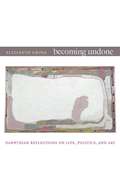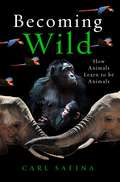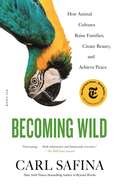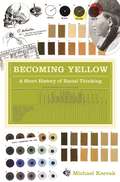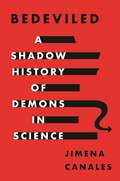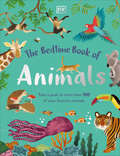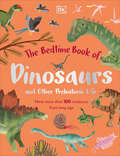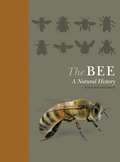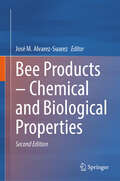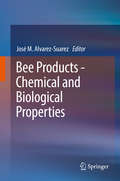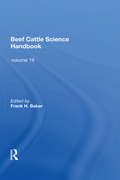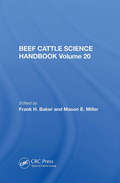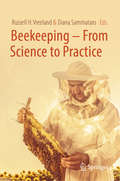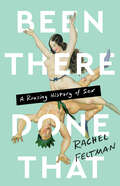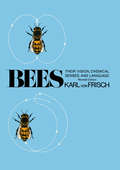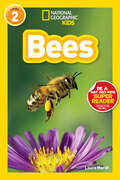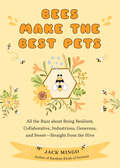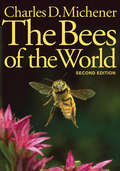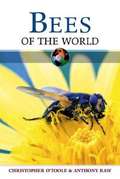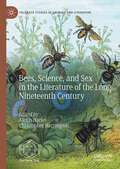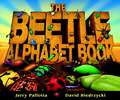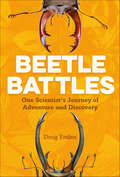- Table View
- List View
Becoming Undone: Darwinian Reflections on Life, Politics, and Art
by Elizabeth GroszIn Becoming Undone, Elizabeth Grosz addresses three related concepts--life, politics, and art--by exploring the implications of Charles Darwin's account of the evolution of species. Challenging characterizations of Darwin's work as a form of genetic determinism, Grosz shows that his writing reveals an insistence on the difference between natural selection and sexual selection, the principles that regulate survival and attractiveness, respectively. Sexual selection complicates natural selection by introducing aesthetic factors and the expression of individual will, desire, or pleasure. Grosz explores how Darwin's theory of sexual selection transforms philosophy, our understanding of humanity in its male and female forms, our ideas of political relations, and our concepts of art. Connecting the naturalist's work to the writings of Bergson, Deleuze, and Irigaray, she outlines a postmodern Darwinism that understands all of life as forms of competing and coordinating modes of openness. Although feminists have been suspicious of the concepts of nature and biology central to Darwin's work, Grosz proposes that his writings are a rich resource for developing a more politicized, radical, and far-reaching feminist understanding of matter, nature, biology, time, and becoming.
Becoming Wild: How Animals Learn to be Animals
by Carl SafinaWho are we? What do we value? How do we live here? Guided by parents, carers, teachers and siblings, we learn to answer these questions as we grow up. But it&’s not just us. Many animals must learn to answer them too. In Becoming Wild, Carl Safina reveals that culture, long thought exclusive to humankind, is abundant in the animal kingdom. Sperm whales in the Caribbean communicate through a system of clicks akin to Morse code, announcing which clan they belong to, which family and who they are individually. Among chimpanzees the obsession with male status may guarantee violence, even war, but they also have many ways to quell tensions. As Safina shows, the better we understand the animals with whom we share this planet, the less different from us they seem.
Becoming Wild: How Animal Cultures Raise Families, Create Beauty, and Achieve Peace
by Carl SafinaNew York Times bestselling author Carl Safina brings readers close to three non-human cultures—what they do, why they do it, and how life is for them.Some people insist that culture is strictly a human feat. What are they afraid of? This book looks into three cultures of other-than-human beings in some of Earth’s remaining wild places. It shows how if you’re a sperm whale, a scarlet macaw, or a chimpanzee, you too experience your life with the understanding that you are an individual in a particular community. You too are who you are not by genes alone; your culture is a second form of inheritance. You receive it from thousands of individuals, from pools of knowledge passing through generations like an eternal torch. You too may raise young, know beauty, or struggle to negotiate a peace. And your culture, too, changes and evolves. The light of knowledge needs adjusting as situations change, so a capacity for learning, especially social learning, allows behaviors to adjust, to change much faster than genes alone could adapt. Becoming Wild offers a glimpse into cultures among non-human animals through looks at the lives of individuals in different present-day animal societies. By showing how others teach and learn, Safina offers a fresh understanding of what is constantly going on beyond humanity. With reporting from deep in nature, alongside individual creatures in their free-living communities, this book offers a very privileged glimpse behind the curtain of life on Earth, and helps inform the answer to that most urgent of questions: Who are we here with?
Becoming Yellow: A Short History of Racial Thinking
by Michael KeevakThe story of how East Asians became "yellow" in the Western imagination—and what it reveals about the problematic history of racial thinkingIn their earliest encounters with Asia, Europeans almost uniformly characterized the people of China and Japan as white. This was a means of describing their wealth and sophistication, their willingness to trade with the West, and their presumed capacity to become Christianized. But by the end of the seventeenth century the category of whiteness was reserved for Europeans only. When and how did Asians become "yellow" in the Western imagination? Looking at the history of racial thinking, Becoming Yellow explores the notion of yellowness and shows that this label originated not in early travel texts or objective descriptions, but in the eighteenth- and nineteenth-century scientific discourses on race.From the walls of an ancient Egyptian tomb, which depicted people of varying skin tones including yellow, to the phrase "yellow peril" at the beginning of the twentieth century in Europe and America, Michael Keevak follows the development of perceptions about race and human difference. He indicates that the conceptual relationship between East Asians and yellow skin did not begin in Chinese culture or Western readings of East Asian cultural symbols, but in anthropological and medical records that described variations in skin color. Eighteenth-century taxonomers such as Carl Linnaeus, as well as Victorian scientists and early anthropologists, assigned colors to all racial groups, and once East Asians were lumped with members of the Mongolian race, they began to be considered yellow.Demonstrating how a racial distinction took root in Europe and traveled internationally, Becoming Yellow weaves together multiple narratives to tell the complex history of a problematic term.
Bedeviled: A Shadow History of Demons in Science
by Jimena CanalesHow scientists through the ages have conducted thought experiments using imaginary entities—demons—to test the laws of nature and push the frontiers of what is possible Science may be known for banishing the demons of superstition from the modern world. Yet just as the demon-haunted world was being exorcized by the enlightening power of reason, a new kind of demon mischievously materialized in the scientific imagination itself. Scientists began to employ hypothetical beings to perform certain roles in thought experiments—experiments that can only be done in the imagination—and these impish assistants helped scientists achieve major breakthroughs that pushed forward the frontiers of science and technology.Spanning four centuries of discovery—from René Descartes, whose demon could hijack sensorial reality, to James Clerk Maxwell, whose molecular-sized demon deftly broke the second law of thermodynamics, to Darwin, Einstein, Feynman, and beyond—Jimena Canales tells a shadow history of science and the demons that bedevil it. She reveals how the greatest scientific thinkers used demons to explore problems, test the limits of what is possible, and better understand nature. Their imaginary familiars helped unlock the secrets of entropy, heredity, relativity, quantum mechanics, and other scientific wonders—and continue to inspire breakthroughs in the realms of computer science, artificial intelligence, and economics today.The world may no longer be haunted as it once was, but the demons of the scientific imagination are alive and well, continuing to play a vital role in scientists' efforts to explore the unknown and make the impossible real.
The Bedtime Book of Animals (The Bedtime Books)
by DKA must-have illustrated introduction to the animal kingdom, including over 50 of the world&’s favorite animals! Introducing The Bedtime Book of Animals, a must-have animal reference book for all early readers who are keen to explore animals from all over the globe. Turn each page to find out more about a wide variety of animals, from teeny-tiny insects to gigantic elephants and whales. The Bedtime Book of Animals showcases creatures from each of the core animal groups (mammals, birds, reptiles, amphibians, fish, and invertebrates) in six dedicated chapters. Many pages are devoted to a different creature, with others featuring a collection of animals from the same family, and some explore more than one animal type, giving bite-sized chunks of accessible information to help early learners get to know new species.A fun-filled journey into the animal kingdom awaits you, promising: - A must-have introduction to a wide variety of animals from around the world- Introduces essential information about each species in a friendly, accessible way- Colorfully illustrated, with light annotation of key features- Reinforces early animal vocabulary, and builds awareness of connections in the animal kingdom- Fully illustrated, with a bright color palette and fresh feel. From rabbits and red pandas, starfish to songbirds, The Bedtime Book of Animals is a beautiful, fully-illustrated and, engaging picture book with read-alout text– perfect for parents/carers and children to enjoy at bedtime. A must-have volume to add to every 3-5 year old&’s library, this is a one-hit introduction to animals, featuring more than 50 best-loved and lesser-known animals from around the world. Did you know that the topic of animals is universally popular and this is a tried-and-tested non-fiction genre, which can help to develop early understanding of the natural world in young readers, as well as develop soft skills such as empathy, kindness and care in 3-5-year-olds? Perfect for parents and educators seeking to introduce core animal knowledge at a young age, including how to recognize animals, animal categorization and key features. A friendly, factual, timeless gift book, The Bedtime Book of Animals will be treasured forever.
The Bedtime Book of Dinosaurs and Other Prehistoric Life: Meet More Than 100 Creatures From Long Ago (The Bedtime Books)
by Dean LomaxGet to know more than 100 of the world&’s favorite dinosaurs and other prehistoric life forms with this essential illustrated introduction.This must-have first book on dinosaurs and other ancient creatures is filled with beautiful illustrations and storybook text on every page, perfect for early readers who want to know more about the life that once roamed our planet. The Bedtime Book of Dinosaurs and other Prehistoric Life includes the earliest life that appeared in the ocean, to the giant dinosaurs, and the wonderfully weird mammals that followed them. Children aged 3-5 can discover a huge variety of organisms that are shown within the three chapters, which cover the Paleozoic, Mesozoic, and Cenozoic eras. With old favorites, such as Tyrannosaurus and Triceratops, as well as new discoveries, including Yi and Changmiania, there is something for every young fan of the primeval world.Inside the pages of this exciting dinosaur book, you&’ll find:- An introduction to the essential information about each prehistoric species in a friendly, accessible way.- Beautiful and accurate illustrations combined with introductory reference text about a wide variety of dinosaurs and other ancient plants and animals.- Engaging text for young children that can be read aloud – perfect for parents, carers, and children to enjoy at bedtime. - A one-hit introduction to prehistoric life, featuring more than 100 animals - an essential addition to every 3–5 year old&’s library.This exciting dinosaur guide helps to develop an early understanding of the prehistoric world for little ones and clearly explains the key features of each animal or plant, as well as how to say their names. A timeless gift book, this is a must-have for parents, carers, and educators who want to introduce core dinosaur knowledge at a young age in a fun and engaging way.
The Bee: A Natural History
by Noah Wilson-Rich Kelly Allin Norman Carreck Andrea QuigleyBees pollinate more than 130 fruit, vegetable, and seed crops that we rely on to survive. Bees are crucial to the reproduction and diversity of flowering plants, and the economic contributions of these irreplaceable insects measure in the tens of billions of dollars each year. Yet bees are dying at an alarming rate, threatening food supplies and ecosystems around the world. In this richly illustrated natural history of the bee, Noah Wilson-Rich and his team of bee experts provide a window into the vitally important role that bees play in the life of our planet. Earth is home to more than 20,000 bee species, from fluorescent-colored orchid bees and sweat bees to flower-nesting squash bees and leaf-cutter bees. This book takes an incomparable look at this astounding diversity, blending an engaging narrative with practical, hands-on discussions of such topics as beekeeping and bee health. It explores our relationship with the bee over evolutionary time, delving into how it came to be, where it stands today, and what the future holds for humanity and bees alike. Provides an accessible, illustrated look at the human-bee relationship over time Features a section on beekeeping and handy go-to guides to the identification, prevention, and treatment of honey bee diseases Covers bee evolution, ecology, genetics, and physiology Includes a directory of notable bee species Presents a holistic approach to bee health, including organic and integrated pest management techniques Shows what you can do to help bee populations
Bee Products – Chemical and Biological Properties
by José M. Alvarez-SuarezThis fully updated and extended second edition provides a comprehensive overview of the most important products by Apis mellifera bees. The book provides an easy-to-read introduction to honey classification, sensory and pollen analysis, and a complete compendium of the chemical composition of the main bee products honey, propolis, royal jelly, pollen and bee venom. In addition, this new edition includes two brand new sections on bee bread and wax. The beneficial medicinal and nutritional aspects of these products in aging and age-related diseases, cancer, neurodegenerative diseases and infections are discussed in detail and the methods used to analyse and characterise the individual bioactive compounds are reviewed. The book is a must for researchers in the field of biochemistry of natural products, students and professional beekeepers interested in the chemical diversity of compounds derived from bee products.
Bee Products - Chemical and Biological Properties
by José M Alvarez-SuarezThis book presents an updated discussion of the chemical composition and biological properties of the main bee products. Specific attention is focused on the beneficial biological activities of bee products in human health. Honey, royal jelly, propolis, bee pollen and bee venom are used as nutriment and in traditional medicine. Their composition is rather variable and depends on the floral source and external factors, such as seasonal, environmental conditions and processing. Bee products are rich in several essential nutrients and non essential nutrients, as sugars, minerals, proteins, free amino acids, vitamins, enzymes and polyphenols, that seem to be closely related to their biological functions. The effects of these products in nutrition, aging and age-related diseases, cancer, neurodegenerative diseases and pathogen infections are discussed.
Bee Time: Lessons from the Hive
by Mark L. WinstonBeing among bees is a full-body experience, Mark Winston writes. Bee Time presents his reflections on three decades spent studying these remarkable creatures, and on the lessons they can teach about how humans might better interact with one another and the natural world, from the boardroom to urban design to agricultural ecosystems.
Beef Cattle Science Handbook, Vol. 19
by Frank H. BakerThe 1983 International Stockinen's School Handbooks include more than 200 technical papers presented at this year's Stockmen's School-sponsored by Wlnrock International-by outstanding animal scientists, agribusiness leaders, and livestock producers expert in animal technology, animal management, and general fields relevant to animal agriculture. The Handbooks represent advanced technology in a problem-oriented form readily accessible to livestock producers, operators of family farms, managers of agri-buslnesses, scholars, and students of animal agriculture. The Beef Cattle Science Handbook, the Dairy Science Handbook, the Sheep and Goat Handbook, and the Stud Managers' Handbook each include papers on such general topics as genetics and selection; general anatomy and physiology; reproduction; behavior and animal welfare; feeds and nutrition; pastures, ranges, and forests; health, diseases, and parasites; buildings, equipment, and environment; animal management; marketing and economics (including product processing, when relevant}; farm and ranch business management and economics; computer use in animal enterprises; and production systems. The four Handbooks also contain papers specifically related to the type of animal considered
Beef Cattle Science Handbook, Vol. 20
by Frank H. BakerThe 1984 International Stockmen's School Handbooks include more than 200 technical papers presented at this year's Stockmen's School, sponsored by Winrock International. The authors of these papers are outstanding animal scientists, agribusiness leaders, and livestock producers who are expert in animal technology, animal management, and gene
Beekeeping – From Science to Practice
by Russell H. Vreeland Diana SammataroThis book will help beekeepers understand the fundamentals of beekeeping science. Written in plain and accessible language by actual researchers, it should be part of every beekeeper's library. The respective chapters not only present raw data; they also explain how to read and understand the most common figures. With topics ranging from honeybee nutrition to strains of Varroa resistant bees, from the effects of pesticide chemicals to understanding diseases, and including a discussion of venom allergies, the book provides essential "knowhow" that beekeepers will benefit from every time they inspect their hives. Further, each chapter ends with the author explaining how beekeepers can (or cannot) directly utilize the information to enhance their beekeeping operation. The text is structured to facilitate ease of use, with each author addressing the same four issues: 1) What are the specific purposes or goals of these experiments? Or more simply: what have these studies taught us? 2) How should a non-scientist read the data generated? 3) What are the key points in relation to practicing beekeepers' goals? 4) How can the data or techniques discussed be applied by beekeepers in their own apiaries? This approach allows readers to look up specific information quickly, understand it and even put it to use without having to read entire chapters. Further, the chapters are highly readable and concise. As such, the book offers a valuable guide and faithful companion for all beekeepers, one they can use day in and day out.
Been There, Done That: A Rousing History of Sex
by Rachel FeltmanA rollicking, myth-busting history of sex that moves from historical attempts at birth control to Hildegard von Bingen&’s treatise on the female orgasm, demystifying plenty of urban legends along the way.Roman physicians told female patients they should sneeze out as much semen as possible after intercourse to avoid pregnancy. Historical treatments for erectile dysfunction included goat testicle transplants. In this kaleidoscopic compendium of centuries-old erotica, science writer Rachel Feltman shows how much sex has changed—and how much it hasn&’t. With unstoppable curiosity, she debunks myths, breaks down stigma, and uses the long, outlandish history of sex to dissect present-day practices and taboos.Feltman&’s mischievous humor dismantles fear and brings scientific literacy to a subject surrounded by misinformation, and indeed, as it gravitates toward the strange, Been There, Done That delivers some sorely needed sex ed. Explorations into age-old questions and bizarre trivia around birth control, aphrodisiacs, STIs, courtship rituals, and more establish that, when it comes to carnal pleasures and procreation, there&’s never been a normal, and sex isn&’t something to be scared of.
Beer Craft: The no-nonsense guide to making and enjoying damn good craft beer at home
by Jon FinchFact: If you can make soup, you can make beautiful and delicious craft beer.Armed with this book, a stock pot and a mesh bag, you'll be drinking your own freshly crafted, hoppy aromatic beers in a matter of weeks. BEER CRAFT will teach you how to make awesome beer, mix tasty beer cocktails and rustle up mouth-watering food, as well as providing a guide to some of the best breweries the craft beer world has to offer.Brewing beer needn't be a complicated, drawn-out process involving a cupboard full of equipment straight out of a laboratory and ingredients you can only order from overseas! BEER CRAFT gives readers a simplified approach to the process, translating the necessary science into layman's terms and making the process fun, approachable and just a little bit rock and roll. A must-have buy for absolutely anyone who likes beer, not just the geeks.Welcome to your new favourite hobby.
Bees: Their Vision, Chemical Senses, and Language
by Karl Von Frisch Donald R GriffinOver half a century of brilliant scientific detective work, the Nobel Prize-winning biologist Karl von Frisch learned how the world, looks, smells, and tastes to a bee. More significantly, he discovered their dance language and their ability to use the sun as a compass. Intended to serve as an accessible introduction to one of the most fascinating areas of biology, Bees (first published in 1950 and revised in 1971), reported the startling results of his ingenious and revolutionary experiments with honeybees.In his revisions, von Frisch updated his discussion about the phylogenetic origin of the language of bees and also demonstrated that their color sense is greater than had been thought previously. He also took into consideration the electrophysiological experiments and electromicroscopic observations that have supplied more information on how the bee analyzes polarized light to orient itself and how the olfactory organs on the bee's antennae function.Now back in print after more than two decades, this classic and still-accurate account of the behavior patterns and sensory capacities of the honeybee remains a book "written with a simplicity, directness, and charm which all who know him will recognize as characteristic of its author. Any intelligent reader, without scientific training, can enjoy it."--Yale Review
Bees (Readers)
by Laura MarshWhat's that buzzing around? It's a busy bee! With beautiful, engaging, and authentic photos, and accessible text, kids will learn all about these incredible insects in this level 2 reader.
Bees Make the Best Pets: All the Buzz about Being Resilient, Collaborative, Industrious, Generous, and Sweet—Straight from the Hive
by Jack MingoAll the Buzz on Bees and BeekeepingWhat happens when a writer sets up a backyard beehive? You get a book full of fun and fascinating facts on bumblebees, honeybees, worker bees, and the rest of our favorite pollinators.A bee swarm of trivia, tips, legend, and lore. Writer and beekeeper Jack Mingo lives with half a million bees. So, it’s safe to say he’s picked up a thing or two at his bee farm. In this collection of humorous, unique, and often unusual observations, Mingo shows us a glimpse of the mystical and matriarchal world of bees and bee culture.A book full of bee facts, anecdotes, and advice. How many legs do bees have? Enough not to crowd your bed at night. They don't track mud or fleas into the house, and if you leave them in the yard they won’t bark and whine. They greet you with honey and beeswax, not dead mice. And these are just some of the reasons bees make the best pets. Whether you’re flirting with beekeeping, looking to save the bees, or growing into your role as reigning queen bee, there’s something new to learn. Step into Mingo’s quirky hive to get a taste of tidbits like:The role of bees in the Civil WarThe legend of caroling bees on Christmas EveThe color and quality of local honeyIf you enjoyed books like The Beekeepers Bible, The Bees in Your Backyard, or The Lives of Bees, then you’ll love Bees Make the Best Pets.
Bees Make the Best Pets: All the Buzz about Being Resilient, Collaborative, Industrious, Generous, and Sweet—Straight from the Hive
by Jack MingoAll the Buzz for Beekeeping Beginners#1 New Release in Entomology and Insects & SpidersWhat happens when a writer sets up a backyard beehive? You get a beekeeping book full of fun and fascinating facts about honey bees and our other favorite pollinators.A nature guide book for beekeeping beginners. Full of trivia, tips, legends, and lore —this quirky bee book swarms with interesting information, so you can have fun, learn stuff, grow your farm, or just relax. Writer and beekeeper Jack Mingo lives with half a million bees, and has picked up a thing or two at his bee farm. In this collection of humorous and often unusual observations, Mingo shows us a glimpse of the mystical and matriarchal world of bees.The save the bees sign you’ve been looking for. How many legs do bees have? Enough not to crowd your bed at night. They don't track mud or bugs into your house, and they won’t bark and whine. They even greet you with raw honey and beeswax. And these are just some of the reasons bees make the best pets of all. Whether you’re a beekeeping beginner, looking to save the bees, or interested in fun nature facts about bugs and insects, there’s something here for every nature lover.Step into Mingo’s hive for tidbits like:Fun and interesting tips and tricks for beekeeping beginnersKnowledge about the color, quality, and benefits of local honeyThe history and legendary stories of bees, like the role they played in the Civil War and the Legend of the Caroling BeesIf you liked Beekeeping for Dummies, The Beekeeper’s Handbook, or Beekeeping for Beginners, you’ll love Bees Make the Best Pets.
The Bees of the World
by Charles D. MichenerIn this extensive update of his definitive reference, Charles D. Michener reveals a diverse fauna that numbers more than 17,000 species and ranges from the common honeybee to rare bees that feed on the pollen of a single type of plant. With many new facts, reclassifications, and revisions, the second edition of The Bees of the World provides the most comprehensive treatment of the 1,200 genera and subgenera of the Apiformes. Included are hundreds of updated citations to work published since the appearance of the first edition and a new set of plates of fossil bees.The book begins with extensive introductory sections that include bee evolution, classification of the various bee families, the coevolution of bees and flowering plants, nesting behavior, differences between solitary and social bees, and the anatomy of these amazing insects. Drawing on modern studies and evidence from the fossil record, Michener reveals what the ancestral bee—the protobee—might have looked like. He also cites the major literature on bee biology and describes the need for further research on the systematics and natural history of bees, including their importance as pollinators of crops and natural vegetation. The greater part of the work consists of an unprecedented treatment of bee systematics, with keys for identification to the subgenus level. For each genus and subgenus, Michener includes a brief natural history describing geographical range, number of species, and noteworthy information pertaining to nesting or floral biology.The book is beautifully illustrated with more than 500 drawings and photographs that depict behavior, detailed morphology, and ecology. Accented with color plates of select bees, The Bees of the World will continue to be the world's best reference on these diverse insects.
Bees of the World
by Christopher O'Toole Anthony RawDetailed but readable coverage of all aspects of bees, including their diversity, behavior, and life cycle. Describes the solitary as well as the social bees, the flower-bee relationship, the special role of male bees, and the significance of associated insect species.
Bees, Science, and Sex in the Literature of the Long Nineteenth Century (Palgrave Studies in Animals and Literature)
by Alexis Harley Christopher HarringtonThe long nineteenth century (1789-1914) has been described as an axial age in the history of both bees and literature. It was the period in which the ecological and agronomic values that are still attributed to bees by modern industrial society were first established, and it was the period in which one bee species (the European honeybee) completed its dispersal to every habitable continent on Earth. At the same time, literature – which would enable, represent and in some cases repress or disavow this radical transformation of bees’ fortunes – was undergoing its own set of transformations. Bees, Science, and Sex in the Literature of the Long Nineteenth Century navigates the various developments that occurred in the scientific study of bees and in beekeeping during this period of remarkable change, focusing on the bees themselves, those with whom they lived, and how old and new ideas about bees found expression in an ever-diversifying range of literary media. Ranging across literary forms and genres, the studies in this volume show the ubiquity of bees in nineteenth-century culture, demonstrate the queer specificity of writing about and with bees, and foreground new avenues for research into an animal profoundly implicated in the political, economic, ecological, emotional and aesthetic conditions of the modern world.
The Beetle Alphabet Book (Jerry Pallotta's Alphabet Books)
by Jerry PallottaLearn your beetles from A to Z as they crawl their way through the alphabet. Get to know the most diverse species on earth in this entertaining and informative nature ABC book. From the Dung Beetle to the Kalahari Beetle to the Zinc Metallic Beetles, the book is both fact-filled and fun for young readers. Full of Jerry Pallotta's signature humor and brought to life with bold artwork by award-winning illustrator, David Biedrzycki. A great introduction for the insect-enthused and lovers of all things that creep and crawl.
Beetle Battles: One Scientist's Journey of Adventure and Discovery
by Douglas EmlenJoin scientist Doug Emlen on his quest to find out why an elusive type of beetle grows weapons that are enormous for its body size.What does it take to be a scientist in the field? Doug Emlen is a scientist. He studies beetles.Specifically, he studies the evolution of beetle weapons—how their horns and armor change to better suit them in different environments. This book starts with a mystery: Doug wanted to know why a particular type of beetle developed a massive evolutionary weapon. He wanted to know how these changes happened and what advantages these enormous weapons gave the tiny dung beetles. So, he went to visit.Part travel diary and part scientific exploration, Beetle Battles takes you deep into the South American rainforest to monitor beetles in their own habitat. Packed with color photographs, extensive back matter, and entertaining anecdotes, this book will make beetle fans out of all its young readers.
